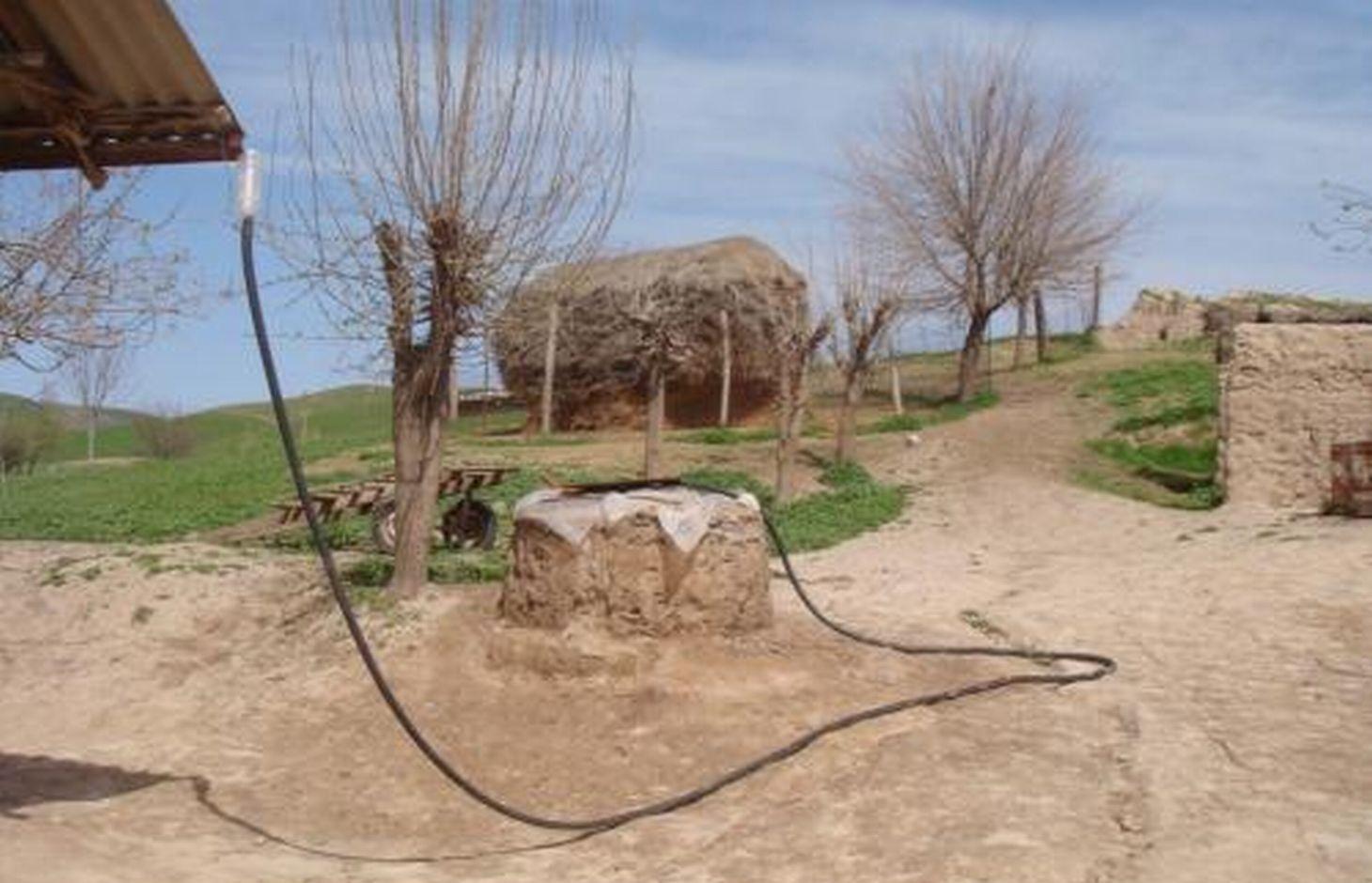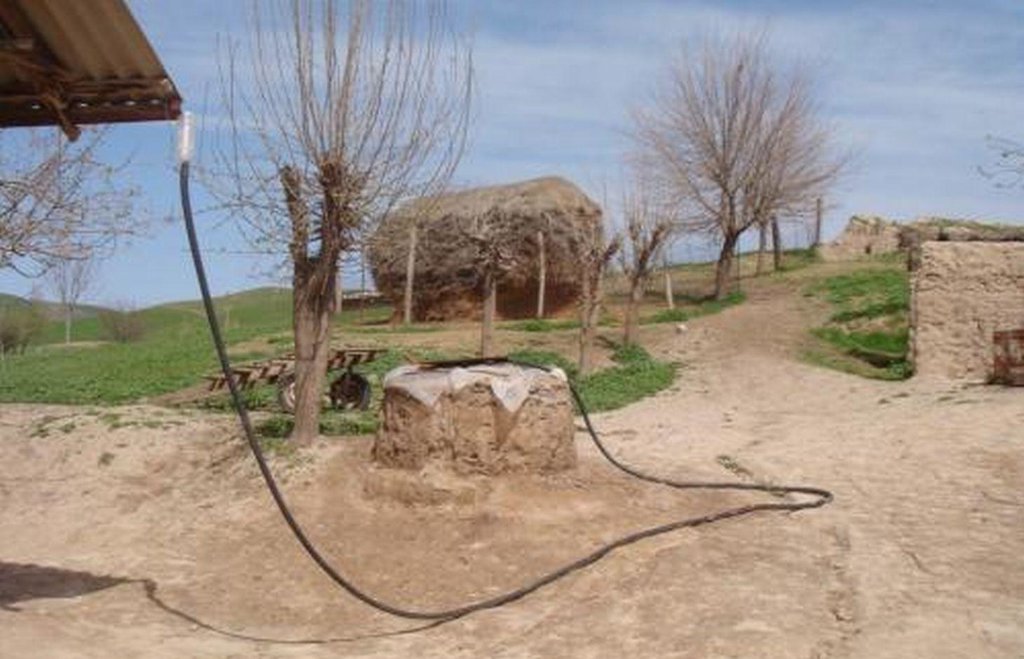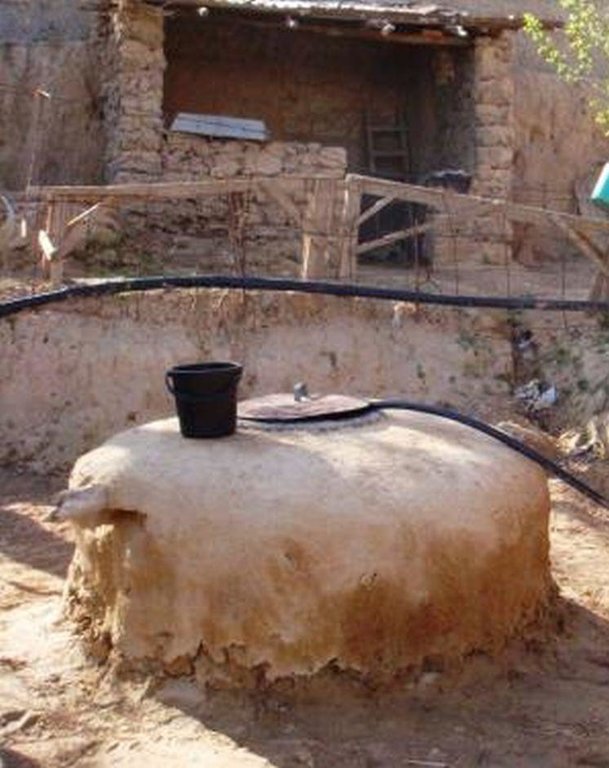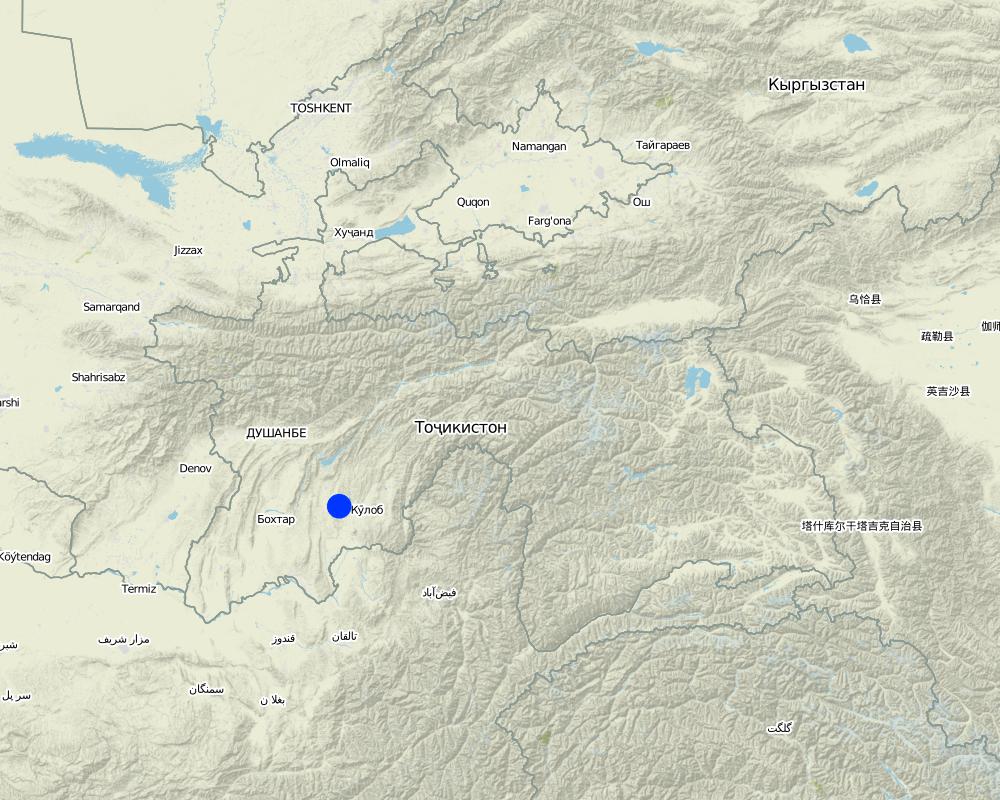Roof top rainwater harvesting stored in a polythene lined earth retention tank. [Tajikistan]
- Creation:
- Update:
- Compiler: Daler Domullojonov
- Editor: –
- Reviewers: Alexandra Gavilano, David Streiff, Deborah Niggli
Чамъоварии оби борон аз руи боми хона
technologies_1446 - Tajikistan
- Full summary as PDF
- Full summary as PDF for print
- Full summary in the browser
- Full summary (unformatted)
- Roof top rainwater harvesting stored in a polythene lined earth retention tank.: Nov. 2, 2021 (public)
- Roof top rainwater harvesting stored in a polythene lined earth retention tank.: April 4, 2018 (inactive)
- Roof top rainwater harvesting stored in a polythene lined earth retention tank.: Aug. 15, 2019 (inactive)
- Roof top rainwater harvesting stored in a polythene lined earth retention tank.: July 19, 2017 (inactive)
- Roof top rainwater harvesting stored in a polythene lined earth retention tank.: May 6, 2017 (inactive)
- Roof top rainwater harvesting stored in a polythene lined earth retention tank.: March 14, 2017 (inactive)
View sections
Expand all Collapse all1. General information
1.2 Contact details of resource persons and institutions involved in the assessment and documentation of the Technology
SLM specialist:
Name of project which facilitated the documentation/ evaluation of the Technology (if relevant)
Book project: Water Harvesting – Guidelines to Good Practice (Water Harvesting)Name of the institution(s) which facilitated the documentation/ evaluation of the Technology (if relevant)
Deutsche Welthungerhilfe (Welthungerhilfe) - TajikistanName of the institution(s) which facilitated the documentation/ evaluation of the Technology (if relevant)
Pilot Program for Climate Resilience Tajikistan (PPCR Tajikistan) - Tajikistan1.3 Conditions regarding the use of data documented through WOCAT
The compiler and key resource person(s) accept the conditions regarding the use of data documented through WOCAT:
Yes
2. Description of the SLM Technology
2.1 Short description of the Technology
Definition of the Technology:
The use of an earth tank lined with a polyethylene sheet to retain rainwater collected from the roof of the house.
2.2 Detailed description of the Technology
Description:
An earth retention tank is a simple low cost structure that can be used to retain rain water from the rooftop. A hole is prepared and lined with a polyethylene sheet to prevent leakage. The top of the hole is covered with a metal lid for access. The roof of the house is fitted with a plastic guttering that captures the rainwater and funnels the water via a plastic pipe into the earth tank. The water in the earth tank then can be utilised for the irrigation of crops (especially during the hot dry summer months), sanitation, and potentially drinking water.
Purpose of the Technology: The population in Southern Tajikistan consists largely of subsistance farmers and are thus highly reliant upon their kitchen garden plots. As the population in the area continues to expand, the pressure on the land increases. The latter is already in a poor state, because it is becoming degraded through deforestation, overgrazing and general over exploitation. There is much precipitation during the rainy season from autumn until spring in Southern Tajikistan, but the scarcity of water from late spring to the end of autumn poses a problem with water shortages.
During the rainy season, a lot of water is lost as surface runoff, this water can be saved in a retention tank to be utilised during the dry season. It can be used to water crops to help increase yields as well as crop diversity and quality. The additional water can also be used for sanitation, drinking water and watering of livestock.
Establishment / maintenance activities and inputs: For the establishment of such a retention tank several steps are needed. In preparation, a rough estimation of the potential volume of harvested rainwater needs to be calculated. Thereafter, a location for the tank needs to be selected so that expenses are minimised and it is easy to access. The establishment of ponds near big trees is not recommended, because the polyethylene layer might be punctured by the roots.
Natural / human environment: The actual steps of constructing the tank involve:
(1) digging the pond, (2) plastering the inside walls with a fine soil and water mixture to smooth them, (3) lining the pond’s walls with double polyethylene layer, (4) connecting the inside polyethylene sheets with the pond coverage through a piece of cord, so that it can be taken out of the pond any time to be cleaned of sediments, (5) covering the pond with any available material such as a soil, water and straw mixture, reinforced by several poles, leaving an opening of 0.25 x 0.25m to extract water, (6) finally connecting the roof to the pond with a plastic pipe. To avoid dirty water flowing from the roof into the pond, the pipe should only be connected to the pond some time after the rainfall has started.
2.3 Photos of the Technology
2.5 Country/ region/ locations where the Technology has been applied and which are covered by this assessment
Country:
Tajikistan
Region/ State/ Province:
Khatlon province
Further specification of location:
Temurmalik, Baljuvon
Specify the spread of the Technology:
- evenly spread over an area
If precise area is not known, indicate approximate area covered:
- 10-100 km2
Map
×2.6 Date of implementation
If precise year is not known, indicate approximate date:
- less than 10 years ago (recently)
2.7 Introduction of the Technology
Specify how the Technology was introduced:
- through projects/ external interventions
Comments (type of project, etc.):
The technology was developed through a Welthunger Hilfe Project and promotion in the local communities started in 2008.
3. Classification of the SLM Technology
3.1 Main purpose(s) of the Technology
- improve production
3.2 Current land use type(s) where the Technology is applied

Settlements, infrastructure
- Settlements, buildings
Remarks:
Kitchen garden
Comments:
Major land use problems (compiler’s opinion): Inefficient natural resource management, which is mainly visual because people throw potential organic fertilisers away instead of spreading them on the fields. Incorrect ploughing techniques which leads to the acceleration of erosion, deforestation and waste of fuel materials in inefficient stoves and ovens. Overgrazing leading to pasture degradation.
Major land use problems (land users’ perception): lack of water
Constraints of settlement / urban
3.4 Water supply
Comments:
Number of growing seasons per year:
1
Specify:
Longest growing period in days: 180Longest growing period from month to month: March - November
3.5 SLM group to which the Technology belongs
- water harvesting
3.6 SLM measures comprising the Technology

structural measures
- S5: Dams, pans, ponds
Comments:
Main measures: structural measures
3.7 Main types of land degradation addressed by the Technology

water degradation
- Ha: aridification
- Hs: change in quantity of surface water
- Hp: decline of surface water quality
Comments:
Main type of degradation addressed: Ha: aridification, Hs: change in quantity of surface water, Hp: decline of surface water quality
Main causes of degradation: soil management (Inproper land management), deforestation / removal of natural vegetation (incl. forest fires) (Cutting trees and shrubs), overgrazing, inputs and infrastructure: (roads, markets, distribution of water points, other, …) (poor water supply)
Secondary causes of degradation: population pressure (the population is increasing over time.), poverty / wealth (lack of funds)
3.8 Prevention, reduction, or restoration of land degradation
Specify the goal of the Technology with regard to land degradation:
- restore/ rehabilitate severely degraded land
Comments:
Main goals: rehabilitation / reclamation of denuded land
Secondary goals: prevention of land degradation, mitigation / reduction of land degradation
4. Technical specifications, implementation activities, inputs, and costs
4.1 Technical drawing of the Technology
Technical specifications (related to technical drawing):
Harvesting water from the household roof to an earth built retention pond with plastic sheet lining. The retention pond is covered with a removable metal plate for access.
Location: Davad village, Vatan jamoat, Temurmalik district,. Khatlon province, Tajikistan
Date: June 2009
Technical knowledge required for field staff / advisors: low (No special knowledge is needed for implementation)
Technical knowledge required for land users: moderate (Any farmer can implement, once they understand the basic concept.)
Main technical functions: control of concentrated runoff: retain / trap, control of concentrated runoff: drain / divert, water harvesting / increase water supply
Dam/ pan/ pond
Depth of ditches/pits/dams (m): 3.5
Width of ditches/pits/dams (m): 1.2
Length of ditches/pits/dams (m): 1.2
Construction material (earth): digging in earth, plastering and cover
Construction material (wood): pole for cover
Construction material (other): polyethelene sheets, plastic pipe
Specification of dams/ pans/ ponds: Capacity 3.96m3
Catchment area: 72 m2m2
Beneficial area: 0.2h.am2
For water harvesting: the ratio between the area where the harvested water is applied and the total area from which water is collected is: 1:0.5
Author:
Daler Domullojonov, 14, Giprozem str., Dushanbe, Tajikistan
4.2 General information regarding the calculation of inputs and costs
other/ national currency (specify):
TJSomoni
If relevant, indicate exchange rate from USD to local currency (e.g. 1 USD = 79.9 Brazilian Real): 1 USD =:
4.5
Indicate average wage cost of hired labour per day:
6.60
4.3 Establishment activities
| Activity | Timing (season) | |
|---|---|---|
| 1. | Manual digging of pond;smoothing and plastering;covering pond | once in the beginning |
| 2. | polyethylene sheet and pipe procurement, preparation and placement; | once in the beginning |
4.4 Costs and inputs needed for establishment
| Specify input | Unit | Quantity | Costs per Unit | Total costs per input | % of costs borne by land users | |
|---|---|---|---|---|---|---|
| Labour | Manual digging of pond | Persons/day | 2.0 | 30.0 | 60.0 | 100.0 |
| Labour | Placing sheet | Persons/day | 0.1 | 30.0 | 3.0 | 100.0 |
| Construction material | Wooden poles for pond | poles | 4.0 | 5.0 | 20.0 | 100.0 |
| Construction material | Earth | tons | 0.1 | 45.0 | 4.5 | 100.0 |
| Construction material | Polyethylene sheet | square meters | 10.0 | 2.3 | 23.0 | 50.0 |
| Construction material | Cord | meter | 20.0 | 0.025 | 0.5 | 50.0 |
| Construction material | Plastic pipe | meter | 5.0 | 2.0 | 10.0 | 100.0 |
| Construction material | Bucket | pieces | 1.0 | 4.5 | 4.5 | 100.0 |
| Total costs for establishment of the Technology | 125.5 | |||||
| Total costs for establishment of the Technology in USD | 27.89 | |||||
Comments:
Duration of establishment phase: 24 month(s)
4.5 Maintenance/ recurrent activities
| Activity | Timing/ frequency | |
|---|---|---|
| 1. | Cleaning of pond (washing out sediments) | once every year |
| 2. | Changing polyethylene sheet;covering | once every 2 years |
| 3. | Changing polyethylene sheet;covering | once per 2 years |
4.6 Costs and inputs needed for maintenance/ recurrent activities (per year)
| Specify input | Unit | Quantity | Costs per Unit | Total costs per input | % of costs borne by land users | |
|---|---|---|---|---|---|---|
| Labour | Cleaning of pond (washing out sediments) | Persons/day | 0.1 | 45.0 | 4.5 | 100.0 |
| Labour | Changing polyethylene sheet (every 2 years) | Persons/day | 1.0 | 10.0 | 10.0 | 100.0 |
| Construction material | Polyethylene sheet | square meters | 10.0 | 2.3 | 23.0 | 100.0 |
| Construction material | Cord | square meters | 1.13 | 8.85 | 10.0 | 100.0 |
| Construction material | Earth | tons | 0.05 | 45.0 | 2.25 | 100.0 |
| Total costs for maintenance of the Technology | 49.75 | |||||
| Total costs for maintenance of the Technology in USD | 11.06 | |||||
Comments:
The above costs were calculated for the building of one retention tank. One household could have several ponds in one kitchen garden.
4.7 Most important factors affecting the costs
Describe the most determinate factors affecting the costs:
The type of earth in Tajikistan is very good for making the retention ponds, the labour is provided by the land user, and the plastic pipes can be manufactured out of empty plastic bottles. The polythene sheet and cord have to be purchased from the shop.
5. Natural and human environment
5.1 Climate
Annual rainfall
- < 250 mm
- 251-500 mm
- 501-750 mm
- 751-1,000 mm
- 1,001-1,500 mm
- 1,501-2,000 mm
- 2,001-3,000 mm
- 3,001-4,000 mm
- > 4,000 mm
Specifications/ comments on rainfall:
Average annual precipitation is 575 mm (according to data from the last 15 years), most of which falls between late autumn and spring time.
Agro-climatic zone
- semi-arid
Thermal climate class: temperate. 3 months below 5 degrees, 7 months above 10 degrees
Continental conditions
5.2 Topography
Slopes on average:
- flat (0-2%)
- gentle (3-5%)
- moderate (6-10%)
- rolling (11-15%)
- hilly (16-30%)
- steep (31-60%)
- very steep (>60%)
Landforms:
- plateau/plains
- ridges
- mountain slopes
- hill slopes
- footslopes
- valley floors
Altitudinal zone:
- 0-100 m a.s.l.
- 101-500 m a.s.l.
- 501-1,000 m a.s.l.
- 1,001-1,500 m a.s.l.
- 1,501-2,000 m a.s.l.
- 2,001-2,500 m a.s.l.
- 2,501-3,000 m a.s.l.
- 3,001-4,000 m a.s.l.
- > 4,000 m a.s.l.
Comments and further specifications on topography:
Altitudinal zone: Mainly communities in this range
5.3 Soils
Soil depth on average:
- very shallow (0-20 cm)
- shallow (21-50 cm)
- moderately deep (51-80 cm)
- deep (81-120 cm)
- very deep (> 120 cm)
Soil texture (topsoil):
- fine/ heavy (clay)
Topsoil organic matter:
- low (<1%)
If available, attach full soil description or specify the available information, e.g. soil type, soil PH/ acidity, Cation Exchange Capacity, nitrogen, salinity etc.
Soil fertility is medium and if it is not overused the fertility can be increased.
Topsoil organic matter: Usually locals collect cow dung and use it as fuel.
Soil drainage / infiltration is medium
Soil water storage capacity is medium because the loess material contains clay material
5.4 Water availability and quality
Ground water table:
5-50 m
Availability of surface water:
poor/ none
Water quality (untreated):
poor drinking water (treatment required)
Comments and further specifications on water quality and quantity:
Ground water table can also be below 50 m.
Availability of surface water is so poor du to deforestation the natural water balance is disturbed.
5.5 Biodiversity
Species diversity:
- low
5.6 Characteristics of land users applying the Technology
Off-farm income:
- 10-50% of all income
Relative level of wealth:
- poor
Individuals or groups:
- individual/ household
Gender:
- women
- men
Indicate other relevant characteristics of the land users:
Land users applying the Technology are mainly common / average land users
Population density: < 10 persons/km2
Annual population growth: 1% - 2%
100% of the land users are poor.
Off-farm income specification: In this example the farmer's son has migrated to Russia.
5.7 Average area of land used by land users applying the Technology
- < 0.5 ha
- 0.5-1 ha
- 1-2 ha
- 2-5 ha
- 5-15 ha
- 15-50 ha
- 50-100 ha
- 100-500 ha
- 500-1,000 ha
- 1,000-10,000 ha
- > 10,000 ha
Is this considered small-, medium- or large-scale (referring to local context)?
- small-scale
5.8 Land ownership, land use rights, and water use rights
Land ownership:
- state
- individual, titled
Land use rights:
- individual
Water use rights:
- individual
5.9 Access to services and infrastructure
health:
- poor
- moderate
- good
education:
- poor
- moderate
- good
technical assistance:
- poor
- moderate
- good
employment (e.g. off-farm):
- poor
- moderate
- good
markets:
- poor
- moderate
- good
energy:
- poor
- moderate
- good
roads and transport:
- poor
- moderate
- good
drinking water and sanitation:
- poor
- moderate
- good
financial services:
- poor
- moderate
- good
6. Impacts and concluding statements
6.1 On-site impacts the Technology has shown
Socio-economic impacts
Production
crop production
fodder production
animal production
Water availability and quality
drinking water availability
Quantity before SLM:
120 litres
Quantity after SLM:
12000 litres
Comments/ specify:
Water storing capacity of household increased
water availability for livestock
irrigation water availability
Income and costs
farm income
Quantity before SLM:
0
Quantity after SLM:
100
Comments/ specify:
vegetables and greens are available for own consumption
workload
Comments/ specify:
no need to carry water
Socio-cultural impacts
food security/ self-sufficiency
Livelihoods and human well-being
Ecological impacts
Water cycle/ runoff
water quantity
Comments/ specify:
more water available
harvesting/ collection of water
Comments/ specify:
more water available
surface runoff
Comments/ specify:
only in kitchen garden
6.3 Exposure and sensitivity of the Technology to gradual climate change and climate-related extremes/ disasters (as perceived by land users)
Gradual climate change
Gradual climate change
| Season | increase or decrease | How does the Technology cope with it? | |
|---|---|---|---|
| annual temperature | increase | well |
Climate-related extremes (disasters)
Meteorological disasters
| How does the Technology cope with it? | |
|---|---|
| local rainstorm | well |
| local windstorm | well |
Climatological disasters
| How does the Technology cope with it? | |
|---|---|
| drought | not well |
Hydrological disasters
| How does the Technology cope with it? | |
|---|---|
| general (river) flood | not well |
Other climate-related consequences
Other climate-related consequences
| How does the Technology cope with it? | |
|---|---|
| reduced growing period | well |
Comments:
To minimise the damage to the polyethylene waterproofing layers and, reduce evaporation rates, pond is covered. As the pond is dug into earth the temperature remains fairly stable. If precipitation decreases less water can be harvested.
6.4 Cost-benefit analysis
How do the benefits compare with the establishment costs (from land users’ perspective)?
Short-term returns:
very positive
How do the benefits compare with the maintenance/ recurrent costs (from land users' perspective)?
Short-term returns:
very positive
Comments:
Before the implementation of this technology, one family would spend an avarage of $44.5 on one truck of water per month. A pond costs around $25 to build, and should provide families with around 4 months worth of water after the rainy season.
6.5 Adoption of the Technology
- > 50%
If available, quantify (no. of households and/ or area covered):
600 households (in an area of 10-100km^2)
Of all those who have adopted the Technology, how many did so spontaneously, i.e. without receiving any material incentives/ payments?
- 11-50%
Comments:
58% of land user families have adopted the Technology with external material support
350 land user families have adopted the Technology with external material support
Comments on acceptance with external material support: In the initial stages of the project, they were provided with 50% of the costs of the polyethylene sheets and cord only.
42% of land user families have adopted the Technology without any external material support
250 land user families have adopted the Technology without any external material support
Comments on spontaneous adoption: After observing the benefits of the technology and the high cost benefit ratio, many people in the community and surrounding villages have replicated this technology themselves.
There is a strong trend towards spontaneous adoption of the Technology
6.7 Strengths/ advantages/ opportunities of the Technology
| Strengths/ advantages/ opportunities in the land user’s view |
|---|
| Easy and quick to establish, and maintain. |
| Strengths/ advantages/ opportunities in the compiler’s or other key resource person’s view |
|---|
|
It is a low cost technology and can be made from many locally available materials. How can they be sustained / enhanced? To disseminate these ideas in areas with water scarcity through local Extension Service providers / NGOs or local inhabitants. |
|
It reduces the time and effort to collect water and also the cost to buy water. How can they be sustained / enhanced? Promotion of different water saving methods and technologies by interested and line departments. |
| More water available for gardening and household purposes |
|
Increases access to water for drinking and sanitation purposes. How can they be sustained / enhanced? Construction of larger and/or more tanks. |
|
Provides water for irrigation during the hot dry months, therefore improving crop diversity and yields. How can they be sustained / enhanced? Training and education on kitchen garden farming techniques to optimise the use of the extra water supply. |
6.8 Weaknesses/ disadvantages/ risks of the Technology and ways of overcoming them
| Weaknesses/ disadvantages/ risks in the land user’s view | How can they be overcome? |
|---|---|
| The polyethylene only lasts for 2-4 years. | To increase the number of layers or use a thicker polyethylene sheet |
| Weaknesses/ disadvantages/ risks in the compiler’s or other key resource person’s view | How can they be overcome? |
|---|---|
| The plastic layers have a limited lifespan. | To find thicker and more hardy materials, or apply multiple layers. |
| Th waterproof layer can easily be degraded by mice and large insects. | |
7. References and links
7.1 Methods/ sources of information
7.2 References to available publications
Title, author, year, ISBN:
Brochure - Converting drought prone areas into productive gardens! Low cost options to improve rainwater harvesting in Southern Tajikistan rain fed areas …. and beyond! 2009
Available from where? Costs?
Welthungerhilfe, Temurmalik office,
Title, author, year, ISBN:
Training film - Simple ways to improve management of kitchen gardens in Southern Tajikistan rain fed areas …. and beyond. 2009
Available from where? Costs?
Welthungerhilfe, Temurmalik office
Title, author, year, ISBN:
Welthungerhilfe project final narrative report (144-912) - 2010
Available from where? Costs?
Welthungerhilfe, Temurmalik office
Links and modules
Expand all Collapse allLinks
No links
Modules
No modules





